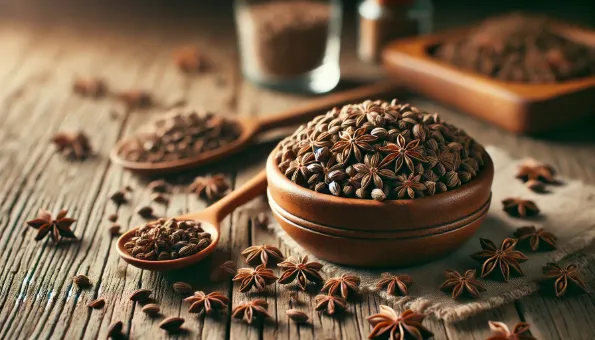Anise Seeds: Sweet-Licorice Spice with Iron, Fiber & Calming Digestive Oils
One tablespoon (6 g) packs 23 kcal, almost 1 mg iron and essential oils that soothe bloating and upgrade baked goods with a warm licorice kick.

What Are Anise Seeds?
True anise (*Pimpinella anisum*) is a Mediterranean umbel whose tiny ridged seeds smell like licorice thanks to the volatile oil **anethole**. Don’t confuse it with star anise—same flavour note, different plant family.
Nutrition per Tbsp whole (6 g)
|Calories|Protein|Fat|Carbs|Fiber|Iron|Calcium|Manganese|
|---|---|---|---|---|---|---|---|
|23 kcal|1.1 g|1.0 g|3.3 g|0.9 g|1.2 mg (7 % DV)|43 mg (4 %)|0.2 mg (9 %)|
Why Add It
- **Carminative oils** (anethole, estragole) relax gut muscles, easing gas & cramps.
- Natural **iron & manganese** support energy metabolism.
- Mild **phyto-estrogens** traditionally used for lactation and PMS relief.
- Potent antioxidants boost shelf-life of granola & spice mixes.
Drawbacks & Safety
- Strong licorice taste—use ¼ tsp in new recipes then adjust.
- Large medicinal doses may interact with estrogen-sensitive conditions; keep to culinary amounts if pregnant.
- Rare cross-allergy with fennel or celery seeds.
Culinary Uses
- **Toast** 1 min in a dry pan for deeper sweetness, then grind.
- Classic in **Italian biscotti, Indian masala chai, Scandinavian rye bread**.
- Simmer ½ tsp with honey for a cough-soothing syrup.
- Sprinkle ground anise + sea salt over roasted carrots or lamb.
Buying & Storage
- Buy **whole, green-brown seeds**; powder loses aroma fast.
- Store in an airtight jar away from light—flavour holds **12 months**.
- For tea, crush seeds just before steeping for 5 minutes.
- 1. Anise Seeds

